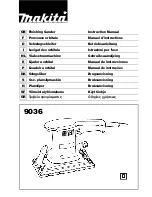
5
ENGLISH
For example, if an abrasive wheel is snagged or
pinched by the workpiece, the edge of the wheel that is
entering into the pinch point can dig into the surface of
the material causing the wheel to climb out or kick out.
The wheel may either jump toward or away from the
operator, depending on direction of the wheel’s move-
ment at the point of pinching. Abrasive wheels may also
break under these conditions.
Kickback is the result of power tool misuse and/or
incorrect operating procedures or conditions and can be
avoided by taking proper precautions as given below.
1.
Maintain a irm grip on the power tool and
position your body and arm to allow you to
resist kickback forces. Always use auxiliary
handle, if provided, for maximum control over
kickback or torque reaction during start-up.
The operator can control torque reactions or kick-
back forces, if proper precautions are taken.
2.
Never place your hand near the rotating acces
-
sory.
Accessory may kickback over your hand.
3.
Do not position your body in the area where
power tool will move if kickback occurs.
Kickback will propel the tool in direction opposite
to the wheel’s movement at the point of snagging.
4.
Use special care when working corners, sharp
edges etc. Avoid bouncing and snagging the
accessory.
Corners, sharp edges or bouncing
have a tendency to snag the rotating accessory
and cause loss of control or kickback.
5.
Do not attach a saw chain woodcarving blade
or toothed saw blade.
Such blades create fre-
quent kickback and loss of control.
Safety Warnings Speciic for Polishing Operations
1.
Do not allow any loose portion of the polish-
ing bonnet or its attachment strings to spin
freely. Tuck away or trim any loose attach-
ment strings.
Loose and spinning attachment
strings can entangle your ingers or snag on the
workpiece.
Additional Safety Warnings
1.
Do not leave the tool running. Operate the tool
only when hand-held.
2.
Check that the workpiece is properly
supported.
3.
If working place is extremely hot and humid,
or badly polluted by conductive dust, use a
short-circuit breaker (30 mA) to assure opera-
tor safety.
4.
Do not use the tool on any materials contain-
ing asbestos.
SAVE THESE INSTRUCTIONS.
WARNING:
DO NOT let comfort or familiarity
with product (gained from repeated use) replace
strict adherence to safety rules for the subject
product. MISUSE or failure to follow the safety
rules stated in this instruction manual may cause
serious personal injury.
FUNCTIONAL
DESCRIPTION
CAUTION:
Always be sure that the tool is
switched off and unplugged before adjusting or
checking function on the tool.
Switch action
CAUTION:
Before plugging in the tool, always
check to see that the switch trigger actuates properly
and returns to the "OFF" position when released.
1
2
1.
Switch trigger
2.
Lock button
To start the tool, simply pull the switch trigger. The
rotation speed will increase as you pull the trigger.
Release the switch trigger to stop. For continuous oper-
ation, pull the switch trigger, push in the lock button and
then release the switch trigger. To stop the tool from the
locked position, pull the trigger fully, then release it.
CAUTION:
Switch can be locked in "ON" posi-
tion for ease of operator comfort during extended
use. Apply caution when locking tool in "ON"
position and maintain irm grasp on tool.
CAUTION:
Do not plug in the tool with the
lock-on switch engaged.
The tool will be run
unsupported and it may cause a personal injury or
breakage.
Speed adjusting dial
1
1.
Speed adjusting dial






























